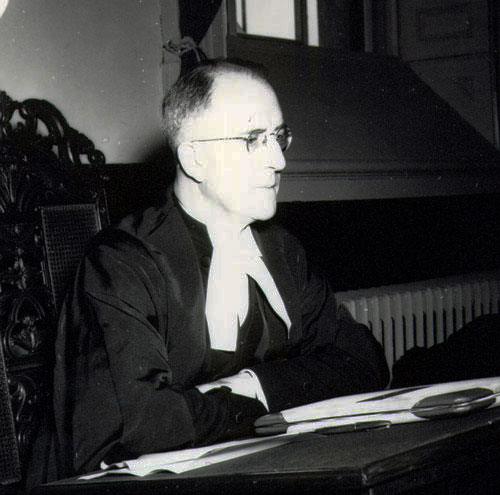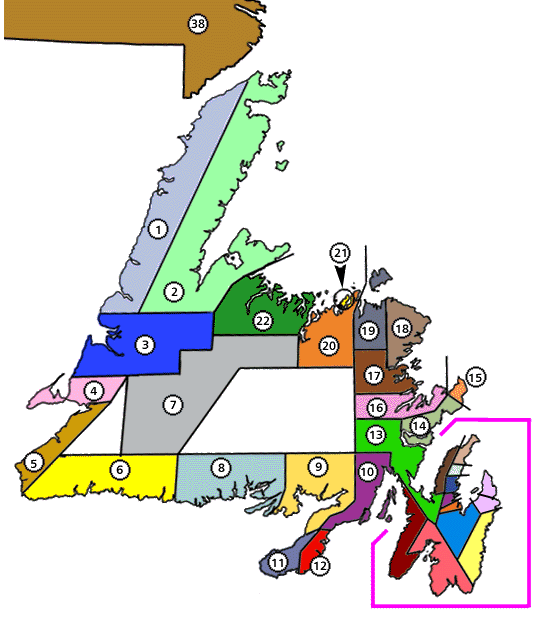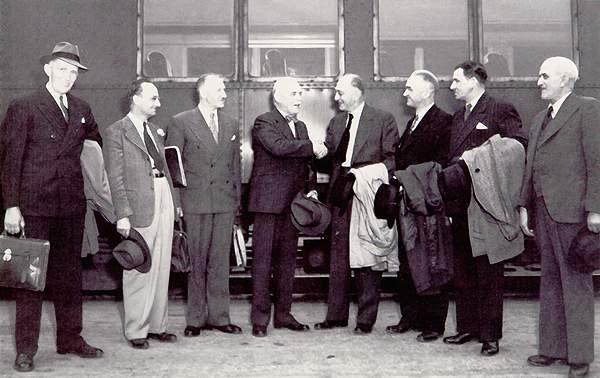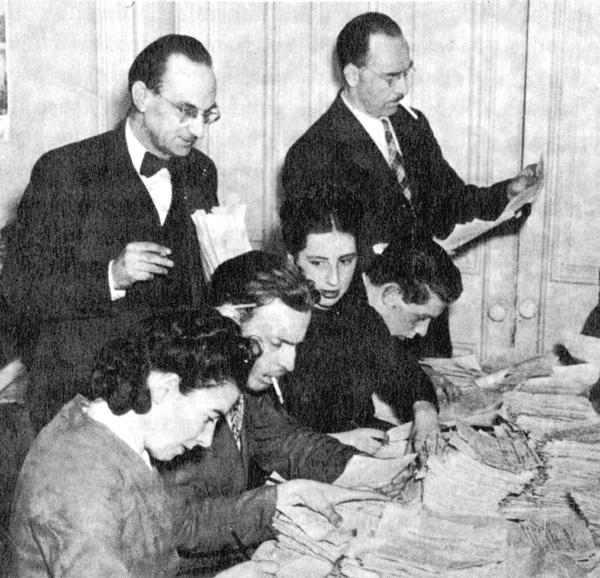The Newfoundland National Convention, 1946-1948
The National Convention consisted of 45 members elected from 38 districts. Its first chairman was Judge Cyril Fox, and under his guidance the Convention began its deliberations on 11 September, 1946.

"The Task"
The task of the National Convention was "to consider and discuss ... the changes that have taken place in the financial and economic situation of the island since 1934, and bearing in mind the extent to which the high revenues of recent years have been due to wartime conditions, to examine the condition of the country and to make recommendations to [the British] Government as to the possible future forms of government to be put before the people at a national referendum."

Ten committees were set up to examine various aspects of the country's economy and society. Their reports were brought to the full Convention for discussion and adoption. When this process was completed, it would be the job of the Finance committee, using the information provided in the reports, to write a consolidated report on the economic and financial situation and outlook. All debates were broadcast over the government radio station, VONF.
At the beginning, members assumed that they would discuss "possible future forms of government" only after committee work was finished. However, this orderly programme was upset on 28 October, when Joseph R. Smallwood (Bonavista Centre) moved that the Convention should send a delegation to Ottawa to ascertain possible terms of union.
Audio of the debate on Smallwood's Motion (1946) to inquire into possibility of union with Canada.From the album ...and oh, what a battle it was!: the debate, motion and vote on Newfoundland's entry into Confederation (3:42)
Smallwood was one of the few members who openly supported confederation. His motion found only 17 supporters, and sparked a bitter and divisive debate which polarized the Convention. In these circumstances, an impartial assessment of the country's condition and prospects became a near impossibility.
In the end, the Convention decided to send delegations to London and to Ottawa, both of them led by the Convention's new chairman, F. Gordon Bradley (Bonavista East), himself an active confederate. (Fox had died on 16 November 1946).

London and Ottawa Delegations
The London Delegation was composed mainly of anti-confederates, of whom the most vocal was the outspoken Major Peter Cashin (St. John's West). It left Newfoundland on 25 April 1947, and had three frosty meetings with a British delegation headed by the Dominions Secretary, Viscount Addison. The British made it clear that if Newfoundland returned to responsible government, it could expect no financial or economic assistance. This unhelpful attitude enraged anti-confederate leaders, Cashin making an emotional speech to the Convention on 19 May claiming that a conspiracy existed "to sell this country to the Dominion of Canada".
Audio of Major Cashin's report from London delegation.From the album ...and oh, what a battle it was!: the debate, motion and vote on Newfoundland's entry into Confederation (2:52)
The Ottawa delegation departed on 19 June. Bradley told the Convention they would be back within a month. However, he and Smallwood, who was a member of the delegation, had no such intention. Their idea was to stay in Ottawa until they obtained from the Canadian government acceptable draft terms of union which could be discussed by the Convention and the electorate. This process would, they hoped and expected, postpone the referendum from the fall of 1947, as planned - until sometime in 1948. This would give confederates more time to preach their gospel.
This strategy succeeded. Draft terms of union were indeed negotiated, and the delegation did not return until early October. Anti-confederates were infuriated at this turn of events. Bradley was forced to resign as chairman of the Convention - his replacement was another confederate, John McEvoy, which now turned to the final stages of its business.
It dealt first with the financial and economic reports prepared by the Finance Committee, which was chaired by Peter Cashin. Both of these were highly optimistic documents, and can be considered anti-confederate manifestos. Then Smallwood led the debate on the Ottawa delegation's report and the draft terms, which lasted from 20 November until 16 January, 1948.
Audio of Smallwood's tabling of report of Ottawa delegation and raising of point of privilegeFrom the album ...and oh, what a battle it was!: the debate, motion and vote on Newfoundland's entry into Confederation (5:00)
Reccommending Forms of Government
Finally, the Convention had to recommend which forms of government should appear on the referendum ballot. All members agreed that both responsible government and the continuation of Commission government should be on the ballot. Smallwood then moved on 23 January that confederation with Canada should be a third option.

The debate that followed was the climax of the Convention, long and emotional, ending at 5.30 am on 28 January. The motion was defeated, by 29 votes to 16, and two days later the Convention dissolved.
Audio of the motion to put Confederation on Ballot Paper for National Referendum (1948)From the album ...and oh, what a battle it was!: the debate, motion and vote on Newfoundland's entry into Confederation (18:09)
Audio of the vote on the motionFrom the album ...and oh, what a battle it was!: the debate, motion and vote on Newfoundland's entry into Confederation (2:15)
The anti-confederate victory was short-lived. Early in March the British government announced that confederation would be placed on the ballot after all. It was not going to let the chance slip away.
Some historians have played down the importance of the National Convention. Another view, however, is that it played a significant role, even if it was only a talking shop. This is because it did function, as Attlee had wanted, as a vehicle of political education. The political apathy so evident in 1946 was replaced by the enthusiastic involvement, thanks to radio, of an electorate that had become much better informed about the options available -and particularly about confederation, and what joining Canada might offer.
Documentary Video
- The Winding Road to Confederation Part I: The 1869 Election
- The Winding Road to Confederation Part II: Relations with Canada, 1870-1939
- The Winding Road to Confederation Part III: The War Years, 1939-1945
- The Winding Road to Confederation Part IV: The National Convention, 1946-1948
- The Winding Road to Confederation Part V: The 1948 Referendums




